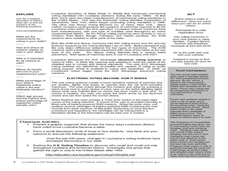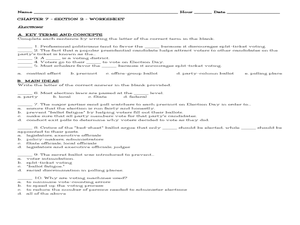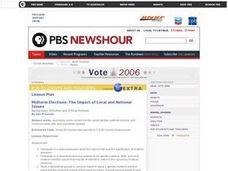Curated OER
Issue 1 - Designed to Add Technology Jobs
Young scholars research the statewide initiative on the Ohio ballot of 2003. They form teams to debate the issue of using bond proceeds to encourage technology research. The class votes on which individual/team presented the best...
Curated OER
Early Voting, Other Election Changes are Possible
Students use the internet and linked sites to explore current voting methods in their community. They research suggestions that have been made for changes and interview people who made these suggestions (when possible). Students suggest...
Curated OER
Voter Fraud: Are Ghosts Going To The Polls
Students research background material about voting in their community. They interview local/county election officials to see what is going on in the community. They also interview teachers, and students to determine if they are newly...
Curated OER
The ABC's of Apportionment
Students are introduced to the terms of apportionment and redistricting. Using a Census map, they identify the states that had the highest and lowest numbers of change during the past ten years. They examine a map of voting districts and...
Curated OER
How We Vote
Students fill in a graphic organizer and discuss the struggles in groups about the history of voting in Louisiana. Students also explore a voting timeline to see who could and could not vote before and after 1850.
Curated OER
Right to vote...in the wrong place
Students create a presentation for other class members or for a local citizens' group explaining how they can guard ensure voter rights. Students research the Ohio Secretary of State's stand on provisional voting rules.
Curated OER
Voting Simulation
Students explore the process of voting. They study the lawmaking branch of the state government.
Curated OER
Elections: Ch 7
Identify the main idea, key terms, and concepts with this activity on US Elections. There are 5 fill in the blank and 5 multiple choice questions for your class to answer.
Curated OER
ONE VOTE
In order to understand the political process and the importance of voting, pupils will construct a class time line. They will group up and research a specific era, creating a time line of political events where one vote made a...
Curated OER
By George, I Think We Have It: Bicentennial quarter reverse
Voting is one of the major reasons the US adopted public education. Educate your class populace, they will analyze the images on a bicentennial quarter and think about the contributions George Washington made to the United States. They...
Curated OER
Voter Behavior
Transform your government students into informed voters with this straightforward worksheet. Five matching questions and five multiple choice questions test students' knowledge on voter behavior and political parties, and the format...
Curated OER
Registering to Vote
Eighth graders register to vote. In this registration lesson, 8th graders complete the first step of the voting process by completing a form. Students use this lesson to prepare for a mock election. The lesson is part of a unit.
Curated OER
The constitution and Our Republic
Students record and interpret data. In this constitution activity, students discuss voting and making bar graphs. Students practice voting and do a bar graph activity. Students make visual representations of votes on the board.
Curated OER
Suffrage Strategies: Voices for Votes
Students discuss the history and importance of voting. In this voting lesson, students research the women's suffrage movement and the methods used to change people's beliefs about suffrage for women. Students also create posters to...
Curated OER
Class Book Awards
Students create a class book award. In this book award lesson, students review the book awards already created (Caldecott or Newbery) and look at books that have received these awards. They come up with their own award and nominate new...
Curated OER
Take a Stand
Students explore the importance of taking part in our government. In this government lesson, students decide between several families as to who will recieve a goat. Students try to convince each other who to vote for.
Curated OER
Vote
In this following directions worksheet , students follow a series of specific instructions when coloring a large bubble letter word, "VOTE". This sheet is to encourage voting in U.S. elections.
Curated OER
Voting And Elections
Students examine the voting practices of the past several presidential elections while using data to determine the influence of different factors. They identify the reasons for high or low voter turnout and then display the outcome of...
Curated OER
Growing Voters and Election 2004: Get Out the Vote
Students examine the voting process, the reasons citizens should vote, and participate in a community drive to sign up new voters. After looking at websites, students create a poster that outlines the reasons to vote, participate in a...
Curated OER
What is a Democracy?
Students identify what makes a country democratic and compare United States and Indian political party symbols. They create their own political party and party symbol. They create a campaign speech, participate in the voting process...
Curated OER
My Country, My Country: To Vote or Not to Vote
Students view a film about elections in Iraq. They examine the story of a doctor and his decisions to vote. They work together to complete a worksheet about voter turnout.
Curated OER
Voting
High schoolers investigate voter participation in the U.S. They watch and discuss a Bill Moyers video, complete a handout, and develop a plan to help a community overcome obstacles to voter participation.
Curated OER
Mid-term Elections: The Impact of Local and National Issues
High schoolers discuss the right to vote and the significance of mid-term elections. They research and discuss mid-term issues and the importance of voting in these elections.
Curated OER
All Those In Favor
Young scholars share opinions about measures recently passed in their school, vote on and argue for and against hypothetical school policies, and respond to a "president's" decision to pass or veto the measures.

























